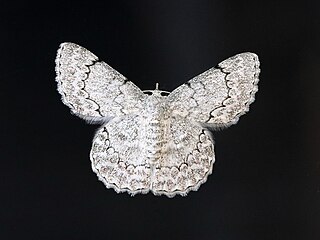
The geometer moths are moths belonging to the family Geometridae of the insect order Lepidoptera, the moths and butterflies. Their scientific name derives from the Ancient Greek geo γῆ or γαῖα "the earth", and metron μέτρον "measure" in reference to the way their larvae, or "inchworms", appear to "measure the earth" as they move along in a looping fashion. A very large family, it has around 23,000 species of moths described, and over 1400 species from six subfamilies indigenous to North America alone. A well-known member is the peppered moth, Biston betularia, which has been subject of numerous studies in population genetics. Several other geometer moths are notorious pests.
Sedenia is a genus of moths of the family Crambidae described by Achille Guenée in 1854.
Amphiongia is a genus of moths of the family Noctuidae. The genus was erected by George Hampson in 1926.

Dithalama is a genus of moths in the family Geometridae.

Eulithis is a Holarctic genus of moths in the family Geometridae erected by Jacob Hübner in 1821.
Homospora is a monotypic moth genus in the family Geometridae described by Turner in 1904. Its only species, Homospora rhodoscopa, was first described by Oswald Bertram Lower in 1902. It is found in Australia.

Problepsis is a genus of moths in the family Geometridae.

Pingasa chlora, the white looper moth or flower-eating caterpillar, is a species of moth of the family Geometridae first described by Caspar Stoll in 1782. It is found Sundaland, the Philippines, Sulawesi and from the Moluccas to Queensland, Australia.
Scopula agrapta is a moth of the family Geometridae. It was described by Warren in 1902. It is found in Kenya, South Africa, Tanzania and Uganda.
Scopula argentidisca is a moth of the family Geometridae. It was described by Warren in 1902. It is found in Kenya, Tanzania and Zambia.
Scopula candidaria is a moth of the family Geometridae. It was described by Warren in 1902. It is found in Kenya, the Democratic Republic of Congo and Uganda.
Scopula fimbrilineata is a moth of the family Geometridae. It was described by Warren in 1902. It is found in Angola, Ivory Coast, Kenya, Malawi and South Africa.

Scopula submutata, the Mediterranean lace border, is a moth of the family Geometridae. It is found in southern Europe, North Africa and the Near East. The habitat consists of open, dry grassland and rocky slopes.
Scopula sybillaria is a moth of the family Geometridae first described by Charles Swinhoe in 1902. It is found in western China, Hong Kong and possibly Borneo.

Scopula pinguis is a moth of the family Geometridae first described by Charles Swinhoe in 1902. It is found in Korea, Japan and Taiwan.
Dithalama punctilinea is a moth of the family Geometridae first described by Charles Swinhoe in 1902. It is found in Western Australia.

Hypodoxa emiliaria is a moth of the family Geometridae first described by Achille Guenée in 1858. It is found in Australia, New Guinea and on the Solomon Islands.
Micrulia medioplaga is a moth in the family Geometridae first described by Charles Swinhoe in 1902. It is found on Borneo, Bali, Sulawesi and Sri Lanka. The habitat mostly consists of lowland forests, but it has also been recorded in lower montane forests.
Sedenia achroa is a moth in the family Crambidae described by Oswald Bertram Lower in 1902. It is found in Australia, where it has been recorded from Western Australia.
Pycnobathra achroa is a moth of the family Gelechiidae. It was described by Oswald Bertram Lower in 1901. It is found in Australia, where it has been recorded from New South Wales.







